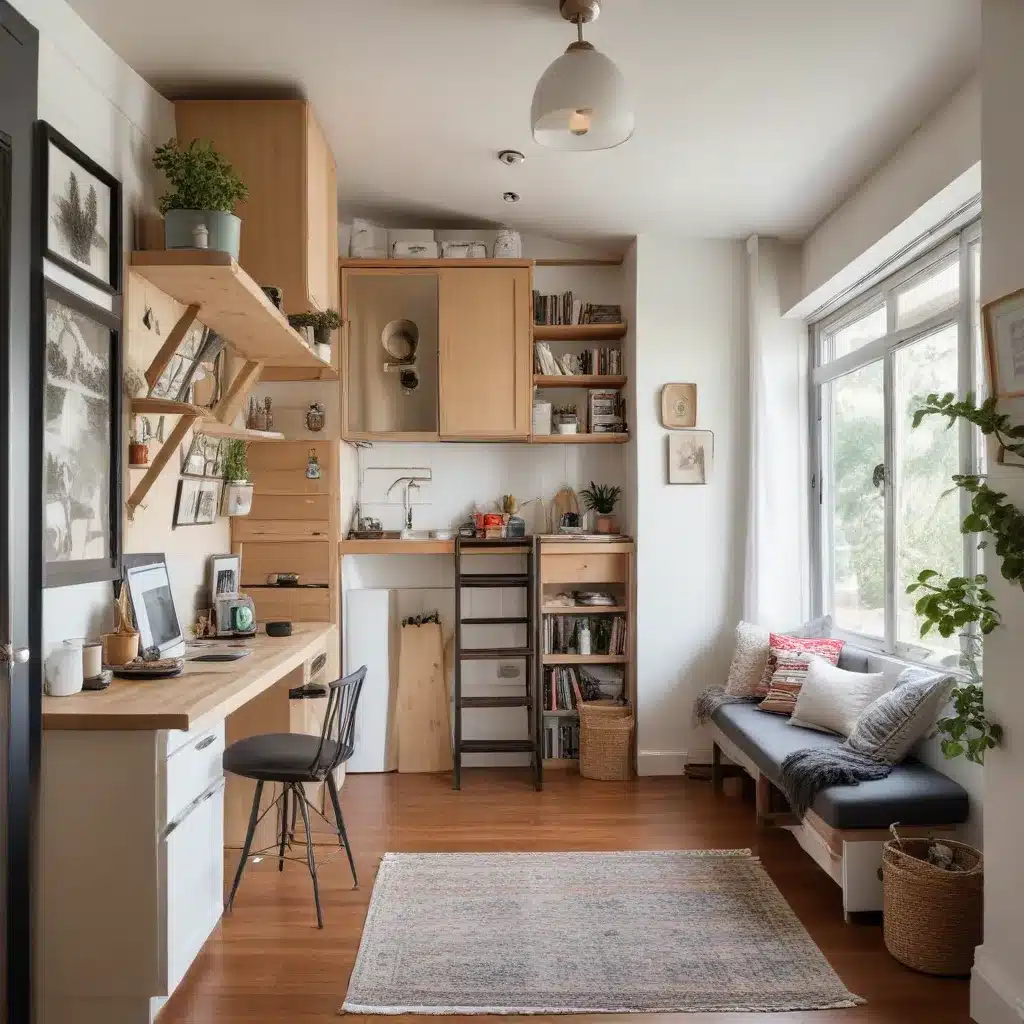
Embracing the Charm of Compact Living
Living in a small home or apartment can pose unique challenges, but it also presents an opportunity to get creative with your space and maximize every square foot. As an experienced construction professional and interior designer, I’ve helped countless clients transform their compact dwellings into functional, stylish, and comfortable living spaces. In this comprehensive guide, I’ll share my top tips and insights on space-saving solutions to help you make the most of your small home.
Efficient Storage Strategies
One of the biggest hurdles in a small space is conquering clutter and finding enough storage. Fortunately, there are numerous clever ways to maximize your available square footage and keep your home organized.
Vertical Storage Solutions
Don’t let valuable wall space go to waste. Utilize vertical storage by installing shelves, hanging racks, and wall-mounted organizers. This allows you to take advantage of underutilized wall areas while keeping frequently used items within easy reach. Incorporate a variety of open and closed storage options to create a balanced, visually appealing look.
Multifunctional Furniture
Invest in furniture pieces that serve dual purposes, such as ottomans with hidden storage compartments, sofas with built-in recliners, or coffee tables with shelves. Carefully selected multipurpose items can help eliminate the need for bulky standalone storage units, freeing up valuable floor space.
Innovative Cabinetry Solutions
Maximize your kitchen and bathroom storage potential by exploring innovative cabinetry options. Install pull-out drawers, lazy Susans, and other organizational inserts to make the most of cabinet interiors. Consider tall, narrow cabinets that extend from floor to ceiling to maximize vertical space.
Decluttering and Editing
In small spaces, it’s essential to regularly declutter and edit your belongings. Keep only the essentials and rotate seasonal items to create a more spacious and calming environment. Employ strategic organization tools, such as bins, baskets, and dividers, to maintain a tidy and visually appealing home.
Optimizing Layout and Flow
The arrangement of furniture and the overall layout of a small space can significantly impact its functionality and perceived size. By carefully planning your room designs, you can create a harmonious and efficient flow.
Scale and Proportion
When selecting furniture for a compact home, pay close attention to scale and proportion. Avoid oversized pieces that can overwhelm a small room. Instead, opt for furnishings with clean, compact silhouettes and elevated off the floor to create a sense of openness.
Zoning and Defining Spaces
In an open-concept floor plan or a studio apartment, use area rugs, furniture arrangements, and subtle design elements to define distinct zones for different activities, such as living, dining, and sleeping areas. This helps to visually organize the space and prevent it from feeling cluttered or chaotic.
Maximizing Natural Light
Leverage the power of natural light to make a small space feel more expansive. Keep window treatments simple and airy to allow light to flow freely, and consider installing mirrored surfaces or reflective accents to enhance the sense of openness.
Flexible and Multifunctional Layouts
Incorporate furniture and design solutions that offer flexibility and can adapt to your changing needs. Murphy beds, convertible sofas, and nesting tables are excellent examples of space-saving pieces that can transform a room’s function as needed.
Cultivating a Visually Expansive Space
The way you decorate and style a small home can have a significant impact on its perceived size and overall ambiance. By implementing strategic design techniques, you can create the illusion of a more spacious and inviting environment.
Color and Texture
Embrace a light, neutral color palette to make a small space feel bright and airy. Incorporate pops of color and textural elements, such as woven baskets, plush rugs, and natural wood accents, to add depth and visual interest without overwhelming the room.
Minimalist Approach
Resist the temptation to overcrowd a small space with too many accessories and decorative items. Adopt a minimalist approach by carefully selecting a few well-placed, high-impact pieces that complement the overall aesthetic and function of the room.
Mirrors and Reflective Surfaces
Strategically placed mirrors can work wonders in a small space by creating the illusion of depth and reflecting natural light. Incorporate mirrored furniture or hang large, decorative mirrors to visually expand the room and enhance the sense of openness.
Architectural Features
Embrace architectural elements, such as built-in shelves, recessed lighting, or decorative moldings, to add visual interest and draw the eye upward, creating the perception of a larger space. Treat these features as design opportunities rather than obstacles to be hidden.
Sustainable and Energy-Efficient Solutions
When renovating or optimizing a small home, it’s essential to consider sustainable and energy-efficient building practices. Not only do these strategies help reduce your environmental impact, but they can also result in long-term cost savings and improved comfort.
Energy-Efficient Appliances and Fixtures
Invest in Energy Star-certified appliances and water-efficient plumbing fixtures to minimize energy and resource consumption. These upgrades can significantly lower your utility bills and contribute to a more sustainable living environment.
Insulation and Air Sealing
Ensure your small home is well-insulated and air-sealed to prevent heat loss or unwanted air infiltration. This will not only enhance energy efficiency but also improve indoor comfort and air quality.
Daylighting and Passive Solar Design
Maximize the use of natural light by strategically positioning windows and incorporating design elements that allow sunlight to penetrate deep into your living spaces. This can reduce your reliance on artificial lighting and contribute to a more energy-efficient, comfortable, and naturally lit home.
Sustainable Materials and Finishes
When selecting materials and finishes for your small home renovation, explore eco-friendly options, such as reclaimed wood, low-VOC paints, and recycled tiles or countertops. These sustainable choices can add character and reduce your environmental footprint.
By implementing these space-saving solutions, design strategies, and sustainable practices, you can transform your compact home into a functional, stylish, and environmentally-conscious living space. Remember, with the right approach, small can be mighty, and your cozy abode can become a true testament to efficient and thoughtful design.


